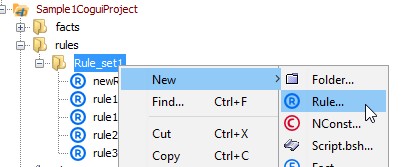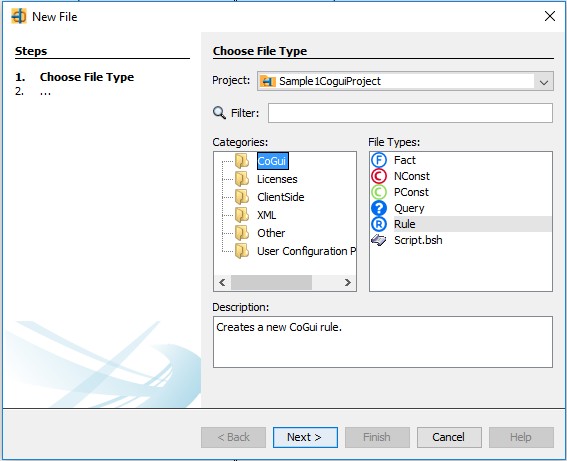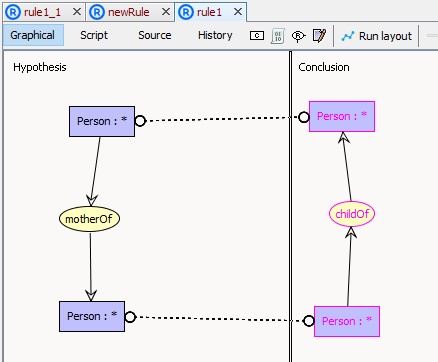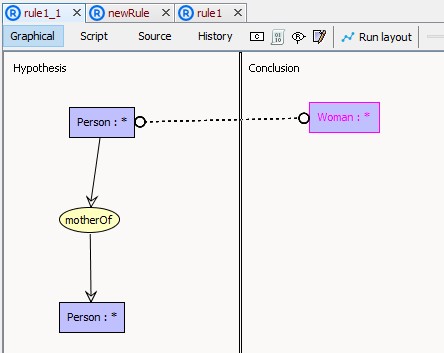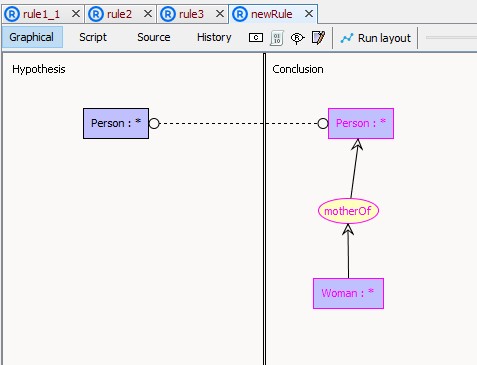Rules
To create a new rule or edit an existing rule go on the projects view and use the popup menu (right-click). As other graphs, rules can be organized in folders. It is particularly interesting to classify the rules on families, especially for testing purposes. Editing rules is very similar to editing Facts. But the split editor is divided in two parts: hypothesis and conclusion. By default hypothesis is placed on the left part and conclusions on right part of the editor. The split bar can be oriented with the mouse to horizontal position, in this case hypothesis is placed on top and bottom is reserved for conclusion.
Create a new rule:
|
If "Rule..." action does not already appears in menu choose "Other..." and select the type of CoGui object that you want to add in your project: |
Rules are used to represent implicit (common sense) knowledge. For instance, let us assume that the fact that Eve is the mother of Abel is represented in a fact graph. If the ontology contains a rule saying that if x is the mother of y then y is a child of x then the system can automatically add the information that Abel is a child of Eve.
Such a rule is represented by two simple graphs. One represents the hypothesis (e.g. [woman]-1-(mother of)-2-[human]) the other represents the conclusion ([human]-1-(child of)-2-[woman]). Furthermore, there is a link between the first person in the hypothesis and the second person in the conclusion, and a link between the second person in the hypothesis and the first person in the conclusion. A rule "if A then B" is used as follows: if an annotation contains A then B can be added to the graph. See below the graphical representation of this rule:
|
A rule example |
A bi-colored representation of this rule could be simplest with just a conclusion relation "child of" added to the hypothesis. The advantage of this representation is that it allow specialization of a concept type in the conclusion. For instance, from the hypothesis [human]-1-(mother of)-2-[human] it can be deduce that the first person is a woman. Thus, rule represented below is more powerful than previous example:
rules could generate some specializations. Here Person is eventually specialized in Woman. |
But it is better to express each deduction in a separate rule and add a new rule to the first one:
|
a simple rule for each deduction |
Do not worry about rule applying order, even if the first rule is not applied in a first step, it can be appliable after applying another one. All rules are tried until saturation (when no rule is appliable).
Due to saturation, rules must be built carefully when at least one rule can create new concepts: The rules may loop and cause an infinite production of concepts. Example below is trivial but combinations of rules can generate loops very difficult to detect.
|
This rule will cause a loop |
Fortunately it is possible to interrupt the saturation running task if it did not end after a "reasonable" time. And the knowledge base can be queried without using saturation. See Applying rules section and Querying for more about the use of rules.
Created with the Personal Edition of HelpNDoc: Produce electronic books easily
